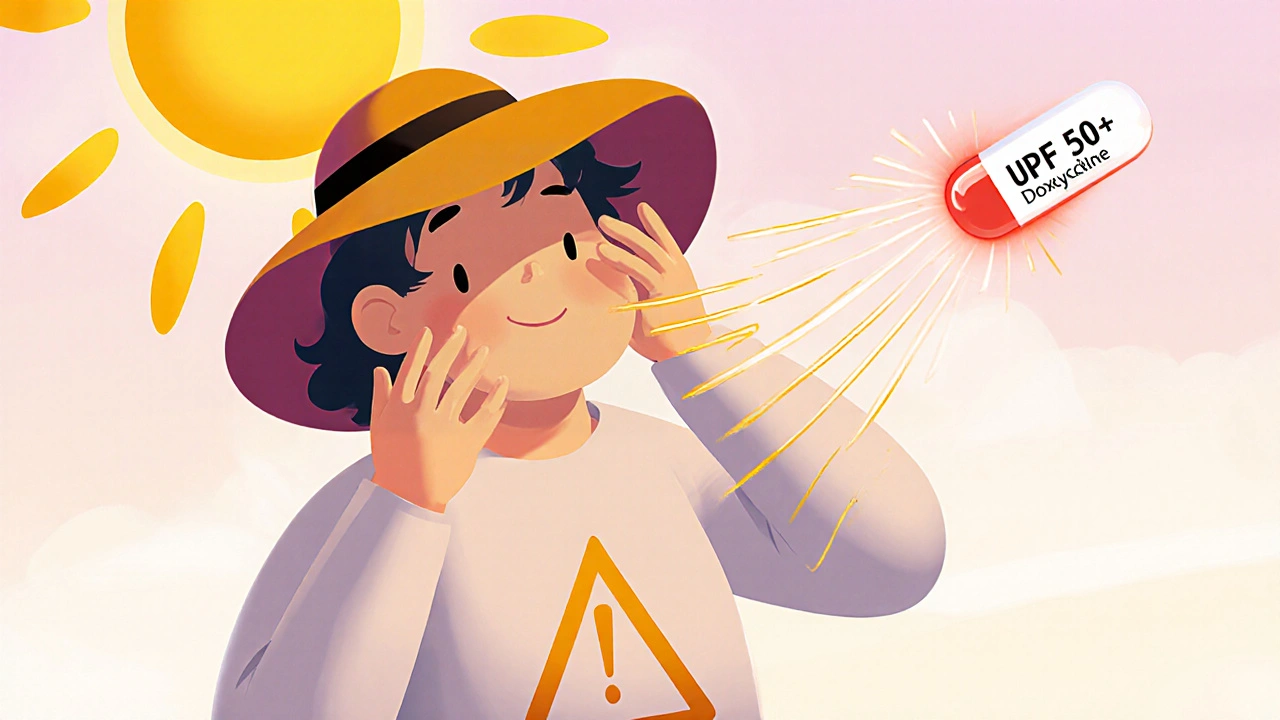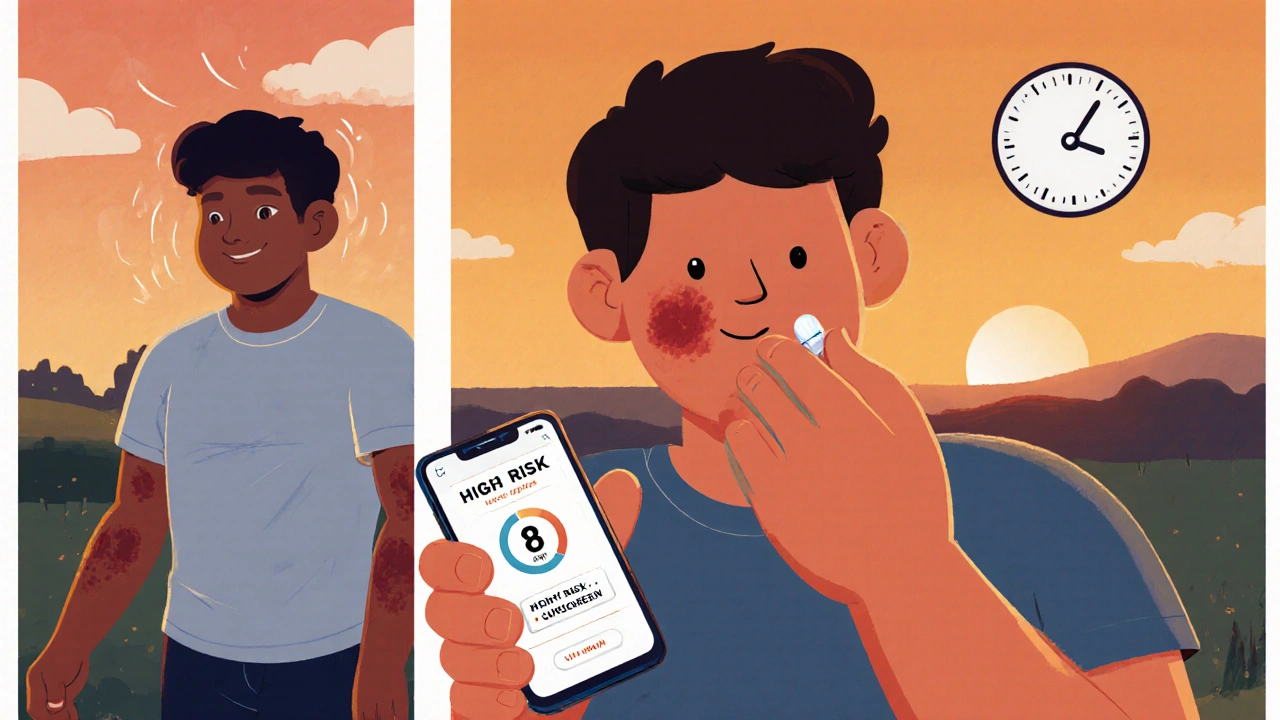How to Prevent Phototoxicity While Taking Antibiotics: Simple, Proven Steps

Antibiotic Phototoxicity Risk Calculator
Calculate Your Phototoxicity Risk
Enter your details to get personalized recommendations for sun protection while taking antibiotics
Your Phototoxicity Risk Assessment
When you’re prescribed an antibiotic like doxycycline or ciprofloxacin, most people focus on finishing the full course and watching for stomach upset. But there’s another hidden risk that can turn a sunny day into a painful experience: phototoxicity. This isn’t a rash or allergy-it’s a chemical reaction between the antibiotic in your bloodstream and sunlight, especially UVA rays. The result? Severe sunburn, blisters, or dark patches on your skin-even if you’ve never burned before.
What Exactly Is Phototoxicity?
Phototoxicity happens when certain antibiotics absorb UV light and trigger a toxic reaction in your skin. It’s not an immune response like a true allergy. Instead, it’s more like your skin is accidentally set on fire by sunlight because the drug is acting like a match. Symptoms usually show up within minutes to hours of sun exposure and can include redness, swelling, burning, and sometimes even blistering. In rare cases, it can lead to long-term dark spots or increase your risk of skin damage over time.Which Antibiotics Are Most Likely to Cause This?
Not all antibiotics carry the same risk. Some are far more dangerous in the sun than others. Here’s what the data shows:- Doxycycline (a tetracycline): Highest risk. Especially above 100mg daily. Used for Lyme disease, pneumonia, acne-common prescriptions.
- Ciprofloxacin and levofloxacin (fluoroquinolones): Moderate risk. Often prescribed for UTIs and respiratory infections.
- Moxifloxacin: Much lower risk. Its chemical structure makes it less reactive to light.
- Minocycline: Lower than doxycycline, but still carries some risk.
- Sulfonamides (like Bactrim): Very low phototoxic risk.
- Cephalosporins (like cefotaxime): Rare, but can cause unusual reactions like spider veins on sun-exposed skin.
If you’re taking doxycycline or ciprofloxacin, you’re in the high-risk group. Don’t assume you’re safe just because you’ve taken it before without issues-phototoxicity can develop suddenly, even after years of use.
Why SPF 30 Isn’t Enough
Most people think if they slap on sunscreen, they’re covered. But when you’re on phototoxic antibiotics, regular SPF 30 is barely enough. Studies show SPF 30 blocks only about 55% of the UV rays that trigger phototoxic reactions. SPF 50+ blocks 92%. That’s a huge difference.Here’s what you need:
- Use a broad-spectrum sunscreen labeled SPF 50 or higher.
- Make sure it protects against UVA (look for “broad-spectrum” and ingredients like zinc oxide, avobenzone, or ecamsule).
- Apply it 15-30 minutes before going outside.
- Reapply every hour if you’re outside, sweating, or swimming. Most people wait too long-and under the stress of antibiotics, sunscreen breaks down faster.
One study found that 68% of patients had no idea they needed to reapply so often. Don’t be one of them.
Clothing Matters More Than You Think
A white cotton T-shirt might feel comfortable, but it only blocks about 60-80% of UV rays. That’s a UPF (Ultraviolet Protection Factor) of 5-10. You need UPF 40 or higher. Look for clothing labeled UPF 50+. These are specially woven fabrics-often polyester blends-that block 98% of UV radiation.Here’s what works:
- Long-sleeve shirts and pants made from UPF-rated fabric.
- Wide-brimmed hats (3 inches or more) block 95% of UV from your face, neck, and ears. Baseball caps? They only protect 45%.
- Sunglasses with UV protection-your eyes can also be affected.
Don’t rely on regular clothes. If you’re outdoors a lot, invest in sun-protective clothing. It lasts longer than sunscreen and doesn’t wash off.

Timing Your Dose Can Cut Risk by 37%
This one’s simple, underused, and backed by solid science: take your antibiotic in the evening.For fluoroquinolones like ciprofloxacin and levofloxacin, taking your dose 2-3 hours before bedtime reduces phototoxic reactions by 37%. Why? Because your blood levels peak during the night, not during the day when the sun is strongest. Your skin has less drug in it when you’re exposed to UV light.
This trick doesn’t work for everyone. Doxycycline is absorbed quickly and stays in your system longer, so timing matters less. But for ciprofloxacin, levofloxacin, or gatifloxacin, evening dosing is a game-changer. Talk to your doctor about switching your schedule.
Smart Tools to Help You Stay Protected
Remembering to reapply sunscreen, check the UV index, and avoid midday sun is hard. That’s where tech helps.Apps like UV Lens (used by over 12 million people) give real-time UV alerts based on your location and weather. Some even let you set reminders for sunscreen reapplication and warn you if you’re on a high-risk antibiotic.
In one 2023 study, patients using these apps were 52% more likely to follow sun protection rules than those who didn’t. It’s not magic-but it’s easier than trying to remember everything yourself.
When to Consider a Different Antibiotic
If you’re someone who spends a lot of time outside-construction worker, gardener, teacher, parent at the playground-you might need to ask your doctor: Is there a safer option?For example:
- Instead of doxycycline for Lyme disease, some doctors may consider amoxicillin if the infection isn’t severe.
- For a UTI, cefdinir (a cephalosporin) has almost no phototoxic risk.
- For acne, minocycline is less risky than doxycycline.
One survey found that 28% of dermatologists have switched antibiotics for patients with outdoor jobs because of phototoxicity risk. You have a right to ask. Don’t assume you have to suffer through sunburn just because the prescription says so.

What About Long-Term Use?
Photoprotection works great for short courses-like a 7-day antibiotic for pneumonia. But for long-term use, like acne treatment with doxycycline for months or years, the numbers aren’t kind. Even with perfect sunscreen and clothing, 62% of patients still get breakthrough reactions.That’s why doctors are now looking at alternatives. A new antibiotic called gepotidacin, currently in trials, shows no phototoxicity at all. As these drugs become available, they’ll replace older ones for chronic conditions.
Until then, if you’re on long-term antibiotics, combine all the strategies: evening dosing, UPF clothing, high-SPF sunscreen, and apps. And get yearly skin checks. Phototoxicity doesn’t just hurt-it can increase your risk of skin cancer over time.
What’s New in Prevention?
In 2023, the FDA approved a new oral supplement containing β-carotene and soybean trypsin inhibitor as an add-on for high-risk patients. In clinical trials, it cut phototoxic reactions by 63%. It’s not a replacement for sunscreen-but it’s an extra layer of protection for people who can’t avoid the sun.Also, research now shows skin type matters. People with Fitzpatrick skin types I and II (fair skin, freckles, burns easily) need 37% more protection than those with darker skin. If you’re light-skinned and on doxycycline, you’re at the highest risk. Be extra careful.
Bottom Line: You Can Stay Safe
Phototoxicity isn’t inevitable. It’s preventable. You don’t need to avoid the sun entirely-but you do need to be smarter about how you handle it.Here’s your simple checklist:
- Know if your antibiotic is high-risk (doxycycline, ciprofloxacin = high; moxifloxacin, sulfonamides = low).
- Use SPF 50+ broad-spectrum sunscreen. Reapply every hour if outside.
- Wear UPF 40+ clothing and a wide-brimmed hat.
- Take fluoroquinolones in the evening, not the morning.
- Use a UV index app to plan outdoor time.
- Ask your doctor: “Is there a less sun-sensitive antibiotic for me?”
Every year, millions of people stop their antibiotics early because of painful sunburns. That’s dangerous-it can lead to antibiotic resistance and worse infections. But with these steps, you can finish your course safely. Your skin will thank you.

13 Comments
So basically dont go outside if you on cipro lol
I never knew phototoxicity was a thing until I got second-degree burns from walking to my car after taking doxycycline. My dermatologist said it was the drug. I thought I was just unlucky. This post saved me from another trip to the ER.
This is exactly the kind of practical, life-saving info that gets buried in medical journals. Thank you for breaking it down so clearly. I’ve shared this with my sister who’s on long-term doxycycline for acne-she’s already switched to evening doses and bought UPF clothing. Small changes, huge difference.
USA always overcomplicates everything 🤦♀️ just stay inside bro why you need fancy sunscreen and UPF shirts? In India we just use a towel and chill
Let me just say, as someone who has studied the epidermal response to xenobiotic photosensitization in controlled photobiology labs, the notion that SPF 50+ is sufficient is statistically misleading-especially when considering the nonlinear absorption spectra of fluoroquinolones under ambient UVA flux. The reapplication interval of every hour is not merely recommended-it is biophysically imperative. And yet, 68% of patients remain unaware? This is a systemic failure of pharmaceutical education, not individual negligence.
YES. This. I’m a nurse and I’ve seen so many patients stop their antibiotics because they got burned. I now hand out a printed version of this checklist to every patient on doxycycline or cipro. It’s changed everything. You’re not just protecting skin-you’re protecting public health.
I’ve been on minocycline for three years for acne and I thought I was fine because I used sunscreen. Turns out I was getting subtle hyperpigmentation on my neck and shoulders every summer. I switched to evening dosing and bought UPF 50+ shirts last year and the dark patches stopped getting worse. I didn’t even realize it was the antibiotic until I read this. Thank you. I wish my dermatologist had told me this years ago.
Interesting how the article cherry-picks data to make SPF 50+ seem essential. What about the placebo effect of sun avoidance? And why no mention of the fact that most phototoxic reactions occur in patients who ignore basic precautions regardless of product quality? The real issue is compliance, not sunscreen efficacy.
They don’t want you to know this! Big Pharma doesn’t want you to know you can take your antibiotic at night and avoid the sunburns! They profit off your suffering! They sell you SPF 50+ and UPF shirts and apps and supplements-when all you need is to take it at 8 PM and stay inside! Why won’t the FDA tell you this? It’s a conspiracy!
i never thought about taking antibiotics in the evening i always took them with breakfast but this makes so much sense now i tried it last week with my cipro and i didnt get that weird burn i used to get after gardening i think it worked but i also forgot to reapply sunscreen so maybe its both
UV Lens app is a CIA tool. They track your location, your skin, your meds. Next thing you know they’re selling your sunburn data to insurance companies. Stick to shade. Always.
It is with profound appreciation that I acknowledge the meticulous and evidence-based nature of this exposition. The integration of clinical pharmacokinetics, dermatological photobiology, and behavioral intervention strategies represents a paradigm of patient-centered care. One can only hope that such clarity becomes the standard rather than the exception.
India has been using natural sun protection for centuries-neem oil, turmeric paste, cotton dhotis. Why are we now importing expensive American sunscreen and UPF clothing? This is cultural imperialism disguised as medical advice. 🌞🪷